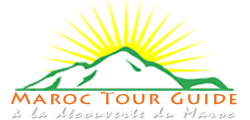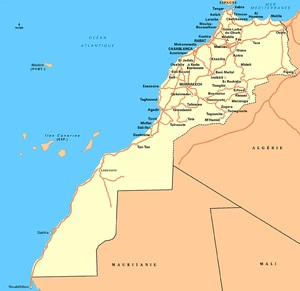About Morocco:
ID card:
Official country name: Kingdom of Morocco.
Capital : Rabat.
Area : 710,850 km ².
Population: 35 million of which 44% is rural. (Berbers, Arabs, Haratin, Jews ...).
Official languages: Arabic and Tamazight, other languages: Moroccan dialect, Hassani, French, Spanish.
State: Constitutional monarchy.
Independence: March 2, 1956 ( from frence).
National Day: July 30-Day Induction of King MOHAMED VI (1999).
Head of State: His Majesty King MOHAMED VI (since 23 July 1999)
HISTORY:
Prehistory.
The man is already present, to 800,000 BC, on the Atlantic coast, as evidenced by the tools found in Casablanca.
Pastoralism.
Around 1600 BC Jc., The Bronze Age, pastors Berbers engrave on rocks of the High Atlas drawings daggers, spears, axes and shields, subjects once used by Mauritania to the two major activities of the moment : hunting and fishing.
The antiquity.
To 800-600 BC., Morocco into history. The Libyan script (Tifinagh), invented by the Berbers, appears in the Atlas and Phoenician are marked on spotted on the island Essaouira to 500 BC., Ethiopians, "those pots that are burned by sun ", settled in Morocco. North, homebodies, they live in cave dwelling, south, nomadic horsemen, they engage in hunting. The Atlanteans, meanwhile, occupy the center of the Atlas and give their name to the Atlantic Ocean.
In the fourth century BC. J-C., Birth of Mauretania
The Greeks called the "Mauritian" Western Libyans names that people in Morocco and western Algeria today is give themselves. Between 25 BC J-C. and 23 AD. AD, Juba II, King of Mauritania, is installed at the head of the Kingdom by Auguste and lives in Volubilis. He describes the country as a book later used by Pliny. It installs purple factories on the island of Mogador, Essaouira off and travels to the Canary Islands by its navy.
In 42 AD J-C., The Roman conquest.
The Roman armies took possession of Mauretania Tingitane, highlighted by the creation of roads, has an agricultural development and an active trade. Tingis, Lixus, Volubilis, Benassa develop. The Roman influence will keep in the south to 429, the date of passage of the Vandals in this part of the Tingitane Mauritania. It seems that from 533, the Byzantine fleet and Visigoth have occupied Ceuta and Essaouira, there remain only a few objects of their passage.
In Short :
146AD : Volubilis (near Meknes) is established by the Romans.
714 : Berbers embrace Islam after first Arab incursions.
788 : First Arab dynasty established in Morocco.
807 : Idris II founds Fez.
1062 : Marrakech founded by the Almoravid dynasty.
1062-1669 : Series of dynasties take power and drive out Christianity.
1912 : The Treaty of Fez when Morocco becomes a French protectorate.
1956 : Morocco gains independence from France.
1975 : The Green March, where 350,000 Moroccans claim the Western Sahara: from Spain.
1976 :Fate of the disputed territory remains undecided.
1999 : King Hassan II dies and his son Mohamed VI takes power.
Language :
Arabic and Tamazight ( Berber) are the official languges, although French is widely spoken, particularly in large cities. Some English is spoken at hotels, restaurants and shops but it is useful to have a sprinkling of French to improve your enjoyment of your trip. In mountain areas various dialects of Berber are spoken, and in more remote villages not even Arabic is spoken, let alone French or English.
Religion :
Islam is the official religion in Morocco and peacefully co-exists alongside other religions.
Each day of the year is marked by five calls to prayer and the muezzins announce prayer times from the top of the mosques' minarets.
Mosques in general are closed to non-Muslims however the Hassan II Mosque in Casablanca, open to non-Muslims every day except Friday, and is well worth a visit.
Please do not be offended if, sitting in a café or walking out of the bank, someone holds out his/her hand to ask for charity, which is an inherent part of Islam - you are free to hand over a dirham, or not. However, please do not give coins, sweets or biros to children as it encourages them to beg from every passing visitor.
Ramadan :
Ramadan is the Holy Month of the Islamic calendar and a time when Muslims fast from first light until sunset. Fasting means 'nil by mouth' including food, water and cigarettes. The day's fast is broken at sunset, often with soup and dates.
Many local cafes and restaurants remain closed during the day however tourists are not expected to fast and there are cafes and restaurants that stay oben to cater for you.
During Ramadan you are encouraged to show your respect by not walking around in public eating, chewing gum, smoking or drinking - it is OK to do so in your hotel, in a cafe/restaurant that stays open and in your vehicle.
During the month you will find that tourist sites often close early to allow staff to return home in time to break their fast and shops often open late and close early, hotel staff may disappear for around 30mins at sunset and your driver/guide will need time to break their fast if you are travelling at sunset.
Geography :
Morocco is the most mountainous country in North Africa and has enormous variations in topography across the country. There are numerous mountain ranges, the most important in terms of land mass are the High Atlas, the Middle Atlas, the Anti-Atlas and the Rif mountains. The Atlas mountains stretch all the way from the Algerian border to the Atlantic coast and have numerous sub-chains. In the south the volcanic ranges of the Sirwa and the Saghro lie just south of the Atlas and other more minor ranges extend towards the desert.
Marrakech sits on a flat (and quite fertile), plain and much of central Morocco is fairly flat and classified as semi-arid.
Morocco has some 3000km of Atlantic and Mediterranean coast, and much of the south of the country is classified as desert. The south of the country in fact borders the Sahara desert.
Environment :
Morocco has a wide diversity of flora, from cedar forests in the Middle Atlas, to oak, thuya and pine forests in the High Atlas. Walnut and almond trees are also widespread in the villages of the High Atlas. Coastal areas support more “Mediterannean” vegetation, and the plains around Marrakech are home to mile upon mile of olive groves and citrus orchards. Vegetation peters out as you head into the deep south, with acacia and date palm trees among the few species to thrive. Spring is a wonderful time to visit the mountain areas of Morocco when snow melt and warm sun spawn great carpets of colourful wild flowers.
Morocco is an interesting and diverse destination for bird watchers. Highlights include one of the last remaining colonies of the bald ibis, on the Atlantic coast, and a huge variety of birds found in mountain habitats. Morocco’s mammals include the Barbary fallow deer, Barbary monkey, Atlas red fox, and wild cats (rarely sighted). Snakes and scorpions are prevalent in desert areas, but rarely cause injury to man!.
Climate :
In a country the size of Morocco and in one with such varying topography it is difficult to generalise about climate so is best divided into zones:
Coastal areas tend to have a less extreme and more temperate climate than the interior, feeling pleasantly warm in winter and not ferociously hot in summer. Most Atlantic regions benefit from a stiff sea breeze which keeps summer temperatures down, and rainfall levels, although not high, are significantly higher than in low lying areas in the interior of the country.
The plains of the interior, for example around Marrakech and Fez show extremes of temperature, from punishingly hot in summer (particularly during July and August) to cold in winter, although the Moroccan sun is always hot, year round. Precipitation levels are very low, and any rain that does fall is most likely in November, February and April.
The Atlas mountains and their associated sub-ranges are subject to variable climatic conditions with much higher levels of precipitation (falling both as rain and snow in the high mountains), and colder – often sub-zero – conditions. There are significant regional variations, but generally the north side of the mountains is more bearably hot in summer, and colder in winter than the south side. Night time winter temperatures can fall as low as -10ºC and daytime summer temperatures can climb into the upper 30sºC.
The south of Morocco is notoriously hot in summer, particularly on the fringes of the Sahara. It’s not the time to visit these regions with burning hot sandstorms regularly flaring up. In winter (particularly December and January), daytime temperatures are very pleasant but there’s a dramatic tailing off by evening time and at night temperatures can drop well below freezing.
The north of Morocco is very lush by comparison as a result of much higher rainfall and temperate conditions.
Please consult your trip dossier for information more specific to your tour.
|
City / Month |
JAN |
FEB |
MAR |
APR |
MAY |
JUN |
JUL |
AUG |
SEP |
OCT |
NOV |
DEC |
|
Agadir |
||||||||||||
|
Temp. maxi. |
20 ° |
22 ° |
22 ° |
22 ° |
24 ° |
24 ° |
26 ° |
27 ° |
27 ° |
26 ° |
23 ° |
20 ° |
|
Temp. mini. |
9 ° |
9 ° |
11 ° |
12 ° |
15 ° |
16 ° |
18 ° |
18 ° |
17 ° |
15 ° |
12 ° |
8 ° |
|
Marrakech |
||||||||||||
|
Temp. maxi. |
18 ° |
20 ° |
22 ° |
24 ° |
28 ° |
31 ° |
40 ° |
40 ° |
32 ° |
27 ° |
21 ° |
18 ° |
|
Temp. mini. |
5 ° |
8 ° |
10 ° |
12 ° |
15 ° |
17 ° |
20 ° |
20 ° |
18 ° |
15 ° |
10 ° |
7 ° |
|
Ouarzazate |
||||||||||||
|
Temp. maxi. |
9 ° |
12 ° |
15 ° |
18 ° |
22 ° |
30 ° |
40 ° |
40 ° |
30 ° |
24 ° |
19 ° |
10 ° |
|
Temp. mini. |
0° |
5° |
15 ° |
18 ° |
22 ° |
27 ° |
30 ° |
29 ° |
25 ° |
24 ° |
16 ° |
6 ° |
 Français
Français 












